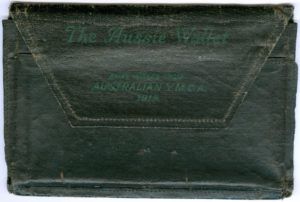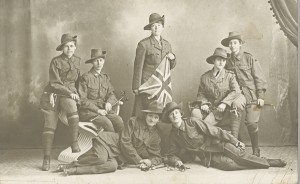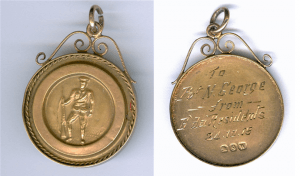Recently Picture Ipswich digitised a collection of war photographs, postcards and memorabilia belonging to the late Norman George of Bundamba. Norman was a gunner during the First World War and was just 18 years old when he enlisted for active service on the 9th of October 1915. At the time of enlistment Norman was employed as a miner and was living with his parents Elizabeth and Herbert and siblings at their Bergins Hill home in Bundamba.
After enlisting for overseas service Norman embarked from Sydney in July 1916 on His Majesty’s Australian Troopship “Orsova”. After arriving in England Norman was sent to a military camp where he remained with his unit for several months. In January 1917 he was shipped to France on the “Princess Henrietta” for active service and assigned to the 3rd Field Artillery Brigade. Shortly after however, he was taken to the hospital after becoming sick, and he remained there for several months before being released on leave in Belgium for rest and recuperation.

‘The Aussie Wallet’ Christmas present presented to Norman George in 1918, whilst serving overseas during World War One – Image courtesy of Picture Ipswich
In October 1917 Norman re-joined the 3rd Field Artillery Brigade in France on the Western Front where he served until December 1918, at which point he was sent to a Casualty Clearing Station after contracting another illness. He was transferred to the Australian Dermatological Hospital in England where he remained for 54 days before being discharged in April 1919. In June 1919 Norman returned to Australia on the Hired Transport Ship the “Themistocles”. For his service and time served overseas during the First World War Norman received the Military star, British Military Medal and the Victory Medal.
During his time spent overseas Norman received many postcards from his large family back home in Bundamba. He also retained several mementos of his time spent overseas including invitations and gifts such as a wallet sent to him for Christmas from the Australian Y.M.C.A. Some of the postcard photographs received from his family included one classic shot of Norman’s mother, Elizabeth with other female members of the family posing with an English flag in Australian soldiers’ uniforms. This was a show of great patriotism and support for both King, Country and the troops serving overseas at the time.

Postcard sent to Norman George by his mother, whilst he was serving overseas during World War One – Image courtesy of Picture Ipswich
Another interesting postcard photograph was a portrait of his two sisters Agnes and Henriette. The photo itself looks like any other portrait, however both women are wearing small gold brooches at their necks in the shape of a wishbone. These pins were known as sweetheart brooches and were worn by mothers, wives, sisters and girlfriends of soldiers who were serving overseas during the First World War. These pins were worn by female relatives to show their support for loved ones serving overseas. The brooches were both commercially produced and hand-made by relatives and were either sent home from the front or purchased by relatives at home. As well as the gold wishbone insignia these brooches were also seen to have other symbols and sayings printed on them such as boomerangs, ‘V for Victory’, ‘Mother’ and stars. They were also not only composed of gold but were made from mother of pearl, silver, and sometimes incorporated precious stones.
In 1919 after returning to Australia from the war, Norman was presented with a small solid gold medallion by the residents of the Bundamba Community for service to his country. Little is known of the medallion itself, however an article which appeared in the Queensland Times newspaper on the 15th of October 1919 states that it was purchased through W. Pratt who was a well-known Ipswich Jeweller at the time. The medallion was presented at a ‘Welcome Home’ celebration at a local hall near Bundamba with music, dancing and refreshments being presented for those attending the special occasion.

Gold medallion presented to Gunner Norman George after returning from service in the First World War, 1919 – Image courtesy of Picture Ipswich
Information taken from: Picture Ipswich; Queensland Times newspaper (15/10/1919); National Australian Archives; Australian War Memorial.
